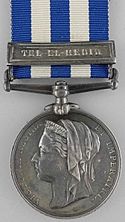Egypt Medal facts for kids
Quick facts for kids Egypt Medal |
|
|---|---|
 
Obverse and reverse of the 1882 medal
|
|
| Type | Campaign medal |
| Eligibility | British and Indian forces. |
| Awarded for | Campaign service |
| Campaign(s) | Egypt |
| Description | Silver, 36 mm in diameter |
| Clasps |
|
| Statistics | |
| Established | 17 October 1882 |
| Related | Khedive's Star |
 Ribbon bar of the medal |
|
The Egypt Medal was a special award given to British soldiers and sailors. It was created in 1882. This medal honored those who fought in Egypt and Sudan. These conflicts happened between 1882 and 1889.
The British got involved in Egypt because of growing problems. Many people in Egypt were unhappy with European influence. This included Britain, especially after the Suez Canal opened in 1869. An Egyptian army group rebelled. This threatened the leader of Egypt, Tewfik Pasha, who was supported by Britain. Britain sent its military to protect its interests. After arriving in Egypt, British forces also got involved in fights in Sudan. Egypt had controlled Sudan since the 1820s.
Everyone who received the Egypt Medal also got another award. This was called the Khedive's Star.
Contents
What Does the Egypt Medal Look Like?
The Egypt Medal was designed with special features:
- It was round and made of silver.
- The medal was about 36 millimeters (1.4 inches) wide.
- On the front, it showed the head of Queen Victoria. She was the Queen of Britain at the time. The words "VICTORIA REGINA ET IMPERATRIX" were also there. This means "Victoria, Queen and Empress" in Latin.
- The back of the medal showed a Sphinx. A Sphinx is a mythical creature, often seen in Egyptian art. The word 'EGYPT' was written above it.
- Medals given for the 1882 campaign had the year "1882" below the Sphinx.
- Medals for service in Sudan from 1884 to 1889 did not have a date. If someone already had the 1882 medal, new bars (called clasps) were added to it.
- Each medal had the soldier's details engraved on its edge. This included their number, rank, name, and army group.
- The ribbon for the medal was 32 millimeters (1.25 inches) wide. It had three blue stripes and two white stripes. All the stripes were the same size.
Special Bars: What Are Clasps?
Clasps are metal bars attached to the ribbon of a medal. They show that the person fought in specific battles or campaigns. The Egypt Medal had 13 different clasps. Two were for the 1882 Anglo-Egyptian War. The other eleven were for service in Sudan between 1884 and 1889.
Clasps for Battles and Campaigns
Here are some of the clasps awarded:
- Alexandria 11 July (1882): For fighting in Alexandria.
- Tel-El-Kebir (13 September 1882): For taking part in a major battle.
- Suakin 1884 (February–March 1884): For service in the Suakin area.
- El-Teb (29 February 1884): For fighting at El-Teb.
- Tamaai (13 March 1884): For fighting at Tamaai.
- El-Teb – Tamaai: Awarded to those who fought in both the El-Teb and Tamaai battles.
- The Nile 1884–85: For service along the Nile River. This was part of an effort to help General Charles George Gordon in Khartoum.
- Abu Klea (17 January 1885): Only given if the person also had "The Nile 1884–85" clasp.
- Kirbekan (10 February 1885): Also only given with "The Nile 1884–85" clasp.
- Suakin 1885 (March–May 1885): Another clasp for service in Suakin.
- Tofrek (22 March 1885): Only given if the person also had "Suakin 1885" clasp.
- Gemaizah 1888 (20 December 1888): For fighting at Gemaizah.
- Toski 1889 (3 August 1889): For fighting at Toski.
Medals Without Clasps
Some people received the medal without any clasps. This happened if they:
- Served in Egypt between July 11 and September 14, 1882. But they were not at the Bombardment of Alexandria or the Battle of Tel-El-Kebir.
- Served south of Wadi Halfa between November 1885 and January 1886.
- Served south of Korosko on August 3, 1889.
Who Received the Egypt Medal?
Most Egypt Medals went to members of the British Army and Royal Navy. But other groups also received this honor:
- Nurses: Seventeen nurses received the medal without a clasp. They helped in hospitals in 1882. This included hospitals in Alexandria and Ismailia. Three of these nurses were not British. These were the first British campaign medals ever given to women.
- Canadian Voyagers: 392 medals with "The Nile 1884-85" clasp went to Canadian voyageurs. These were skilled boatmen. They helped transport supplies along the Nile River. This was the first time Canadians went overseas to help in a British conflict. Many of these voyageurs were First Nations people, especially from the Caughnawaga community.
- Australian Troops: 720 medals with the "Suakin 1885" clasp were given to a force from New South Wales, Australia. This was the first time Australian military units served overseas alongside British troops.
- Egyptian Army: While few Egyptian soldiers were involved in earlier campaigns, many received the "Gemaizah 1888" and "Toski 1889" clasps. These were mostly new Egyptian Army units, including Sudanese battalions. Only one British unit was present at Toski.
Related Medal: Khartoum Siege Medal
There was also an unofficial medal linked to the Egypt Medal. It was called the Khartoum Siege Medal. General Charles George Gordon designed and gave out this medal. It honored officers, soldiers, and civilians. They had defended Khartoum during a siege from 1884 to 1885.
See also

